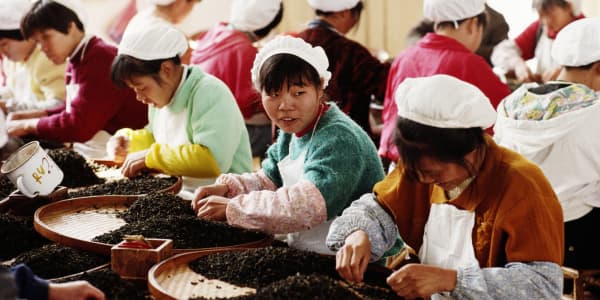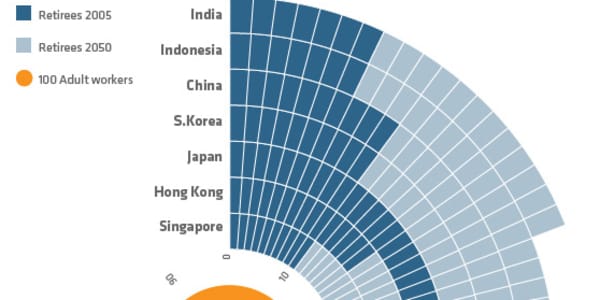With a median population age of around 27, India's relatively young demographic is widely seen as an economic asset, giving the country an edge over its Asian peers, many of which are aging fast.
But analysts warn that it's only a matter of time before South Asia's most populous nation begins to grow old and the country is by many accounts unprepared for this statistical shift.
"There's so much hype around India's demographic dividend, given that 50 percent of the population is below 25 years old, that the sound of the impending 'silver tsunami' is completely drowned out," said Mathew Cherian, CEO of HelpAge India, the country's largest and oldest not-for-profit organization for the elderly.
(Read more: India's secret weapon: its young population)

India's 60-and-over population is currently estimated at 100 million – equivalent to the size of the U.K. and Canadian populations combined – and projected to reach 240 million by 2050.
According to projections by the Census of India, the dependency ratio of India's seniors will reach 19.7 percent by 2050, nearly triple that of 2001, putting the number of dependent seniors on par with the number of dependent children.
"The tipping point is closer than you think. If we don't take action, India's demographic dividend will soon be its demographic burden," Cherian warned.
(Read more: Asia's Pension Plans Face a Big Black Hole)
Cherian is no fear monger; India's social security net has gaping holes. According to a Ministry of Finance Retirement Survey, only 20 million private sector employees and 26 million government employees are eligible for a pension – a fraction of India's 450 million workers.
"Coupled with the social and cultural norm of Indian parents spending most of their savings on their children's education and weddings, even the middle class doesn't have retirement savings to speak of," said John Thattil, COO of non-profit Ummeed and former Regional Director of HelpAge India.
Increasing prosperity in India in India has also proven to be a double-edged sword. While rising property prices have given deeper pockets to the 28 percent middle class and 6 percent elderly people, a massive population migration – from rural to urban areas, between cities, and from India to overseas – has brought about the accompanying trend of children living in far-off places and a crumbling traditional community network, leaving many of the aging demographic having to financially fend for themselves.
(Read more: A Housing Slump in India)
Majority of India's urban-based seniors require various services ranging from money management and shopping services, to transportation and protection against crime. Medical services are required to help with dementia, diabetes, coronary and geriatric problems. Emotional support is also needed to help cope with loneliness and the loss of security.

Indeed, the need to provide more elderly facilities hasn't been lost on entrepreneurs.
Sumer Datta, co-founder of Aamoksha One Eighty, the first private sector company to introduce western-style senior living in India, is setting up resort-style retirement homes in Kodaikanal and Kasauli – southern towns in India which have better weather and less pollution. Visitors to each home will enjoy facilities which include a club house, golf course, bar, a doctor in attendance and a customized diet.
(Read more: Smartphones struggle to connect with the elderly)
"We are introducing a complete lifestyle tailored to the needs of the elderly that will give them joy and happiness," said Datta.
India's largest healthcare group, Max India, is building a similar community in the northern city of Dehradun called Antara Senior Living. The company said it will deliver services on the seven dimensions of wellness – social, emotional, spiritual, physical, occupational, intellectual and environmental.
While these homes may add to a growing industry – Jones Lang LaSalle says India has about 20 privately-run, non-charitable senior living projects and 15 more in the offing – analysts say they pander only to the needs of the middle class who can afford the luxury and prices out 75 percent of the poor seniors living in rural areas.
Real change, according to Helpage India's Cherian, can come only through policy changes and social protection for the aged.
(Read more: India's Air the World's Unhealthiest, Study Says)
The National Social Assistance Program (NSAP), which offers $5 a month pensions for senior citizens, reaches only 16.5 million of the 50 million seniors that would qualify. Government health insurance schemes cover only 5 percent of India's seniors largely due to a lack of awareness of these schemes. Coverage problems are further compounded by the fact that most seniors do not have any form of identity cards and are thus unable to join such social schemes.
HelpAge is lobbying for discounted land sales for old age homes, universal pensions and health insurance backed by an awareness campaign to help the country's elderly gain access to such benefits.
"The real agent of change can only be the government," says Cherian. But in this case, it seems the main player in the game has gone missing.




